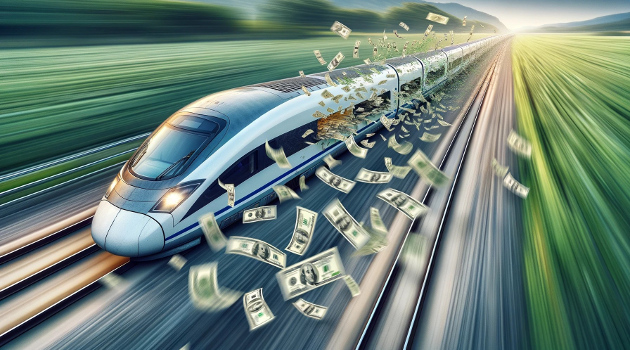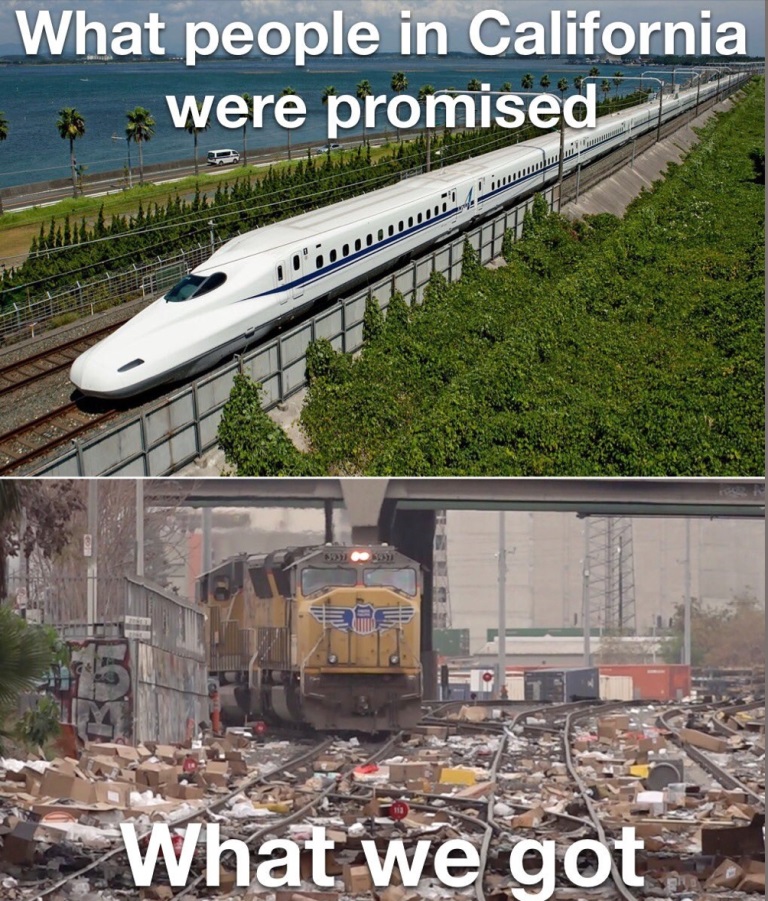California voters made a terrible mistake back in 2008 when they narrowly approved a referendum for a $33 billion high-speed train between San Francisco and Los Angeles.
Opponents said the project was a boondoggle and they made several predictions.
- It will wind up costing far more than advertised.
- It will take much longer to build than initially promised.
- It will benefit special interest groups.
Lo and behold, skeptics were right.
Since I’m a fiscal economist, I was especially interested in the first concern. Based on real-world experience, we know that almost everything government does winds up being very expensive.
Indeed, this pattern is so clear that I wrote a column back in 2017 about the California project’s cost overruns and said it was the “least surprising headline ever.”

New we have another “least surprising headline.”
It’s from KCRA in Sacramento, California’s capital. Here’s what was reported yesterday.

If you want some of the grim details, I’ve excerpted a few sections of the story.
California’s mega high-speed rail project between San Francisco to Los Angeles also faces major funding hurdles, the project’s CEO Brian Kelly told state lawmakers… Kelly told lawmakers the project…was still a few billion dollars short to complete the Central Valley segment between Merced and Bakersfield. …Project leaders estimate it will still need an additional $100 billion to finish what voters were originally pitched in 2008: a bullet train that runs between San Francisco and Los Angeles. A timeline on its completion has not been set.
Here’s some additional analysis on this absurd boondoggle.
Charles Lane of the Washington Post opined on the California project in 2022. Here’s some of what he wrote.
Originally touted as a sub-three-hour link between San Francisco and Los Angeles, this mega-project has not carried a single passenger in the 14 years since the state committed to building it. It has made a lot of public money disappear, though: more than $10 billion…the public was told to expect completion by 2020. …Early on, France’s national railroad company ended its bid to help develop the California line and went somewhere with less red tape: Morocco. …At this point, the best thing for California might be to cut the project’s losses and abandon it. Yes, this would leave in place several massive concrete structures that have been completed. Passersby could look on them as monuments to magical thinking about infrastructure.
That same year, the Wall Street Journal editorialized about throwing good money after bad.
California Democrats once hoped that their 500-mile bullet train from Los Angeles to San Francisco would be a high-speed rail model for the nation. It’s a model, all right—in how politics can drive public works off the rails. …The California High-Speed Rail Authority this week increased its cost estimate for the bullet train to $105 billion from $100 billion two years ago. In 2008 when voters approved $10 billion in bonds for the choo-choo, the estimated price tag was a mere $40 billion. That’s enough to have built 10 large water reservoirs in the parched state. This latest $5 billion doesn’t even account for rapidly rising material and labor costs.
Last but not least, the folks at Reason (who have a long track record of being right on this issue) published a we-told-you-so column.
Here are excerpts from Matt Welch’s article.
The infamous, $113-billion-and-counting California high-speed rail line between San Francisco and Los Angeles, which was supposed to be completed by 2020 for a cost of $33 billion yet has only begun tinkering on a 171-mile stretch in the Central Valley…there never has been, at any stage of this living monument to political unseriousness and hubris, even a “little chance” that the S.F.-L.A. line would zip passengers between the cities in just 160 minutes, let alone deliver on the whole ragbag of laugh-out-loud promises that the state and federal political establishment delivered with a straight face. …There is a point to rehashing these old arguments beyond saying we told you so. The fact is, these reality-based objections were widely known at the time. It’s just that the people who otherwise fashion themselves as serious thinkers about public policy made the conscious choice to jettison rationality in favor of pie-in-the-sky dreaming.
Sadly, this is not just a problem for California taxpayers.
People from every other state are coughing up a lot of money to finance this boondoggle.
One very obvious lesson, therefore, is to get the federal government out of the high-speed rail business, out of the long-distance rail business, out of the mass-transit business, and out of the transportation business.





